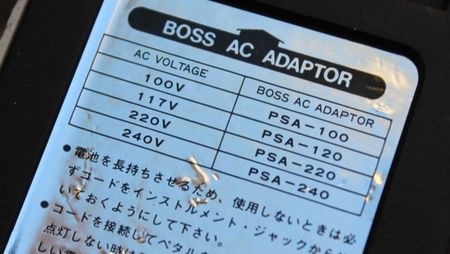Choosing the correct power supply for your Boss pedal can be a slightly confusing task. In general, Boss compact pedals were designed to use one of two adaptors: ACA or PSA. Although both ACA and PSA adaptors (and all Boss compact pedals) use the same sized jack/connectors as each other, their specifications and requirements are different.
If your pedal was built before 1997 then it's most likely made to use what was called the ACA adaptor. Don't confuse this with what's often called an AC adaptor (used on pedals like the Digitech Whammy 4) as these will fry your pedal.
The ACA adaptor was made for the original Boss compact pedals back in 1977. The supply produces 12v's of "unregulated" DC power even though the pedals were designed to run off 9v's of DC power (like a 9v battery). This meant that the Boss designers implemented some internal circuitry in their pedals to drop the voltage down from the 12vDC that the supply produced to the 9vDC that the circuit needed. It's important to note that this circuitry only impacts the power supply input and not the battery snap.
I know what you might be thinking and yes, this was a really strange way to do things. However pedals were only new back then and they were still working out the kinks, so this is just how it was for a few years.
The first Boss pedal not to use this ACA system was the Boss DD-2 in 1983. Due to it's higher than average power requirements, the DD-2 was designed around the new PSA adaptor which produced 9v's of clean, regulated power. Boss continued using both of these power supplies side by side when designing their pedals for a few years until 1997 when they standardised all pedals and solely used the PSA system.
So how do you know which power supply your pedal needs? Firstly, take a look at the label underneath your pedal for a few clues..

The first thing listed on a Boss compact pedal label is the power requirements of that pedal. The table has two columns: AC Voltage and Boss AC Adaptor. The AC Voltage column gives a list of possible voltages from around the world (100v for Japan, 240v for Australia etc). The Boss AC Adaptor column shows you which adaptor is available in which region.
The most important information to note here is whether your pedal is asking for an ACA-XXX or a PSA-XXX adaptor. The first image you see is the label of a ACA powered Boss CS-1 Compression Sustainer, the second is a PSA powered NS-2 Noise Suppressor.
The other notable places you will find information about which supply your pedal needs is on the sticker next to the power jack or on the box (of a PSA pedal, ACA boxes don't tend to have this noted).

So what happens if you use the wrong adaptor? The short answer is not much. Using a PSA adaptor on an ACA pedal will cause the effect to sound weak and possibly muffled. The LED will also likely not turn on. This is all due to the fact that the power is being reduced to around 6v's internally and is not enough to power the pedal properly (much like an old 9v battery would).
To use your old Boss pedal with a modern power supply, there are a few options:
1) The pedals can easily be modified by bypassing the section that reduces the voltage. This often only uses a single wire and can be easily reversed whilst keeping the pedal 100% original. Contact your favourite pedal company (which is hopefully us..) and they can help out with this.
2) If you're using a daisy chain (or any power supply with what's known as "common ground") and have a PSA Boss pedal in the chain then this will bypass the voltage reduction circuitry and your pedal should function fine.
3) Some modern power bricks have 12vDC outputs or even variable power outputs that are capable of 12vDC. These outlets are usually perfectly capable of emulating ACA power. We use our MXR CAE power supply that has a pair of variable voltage outputs.